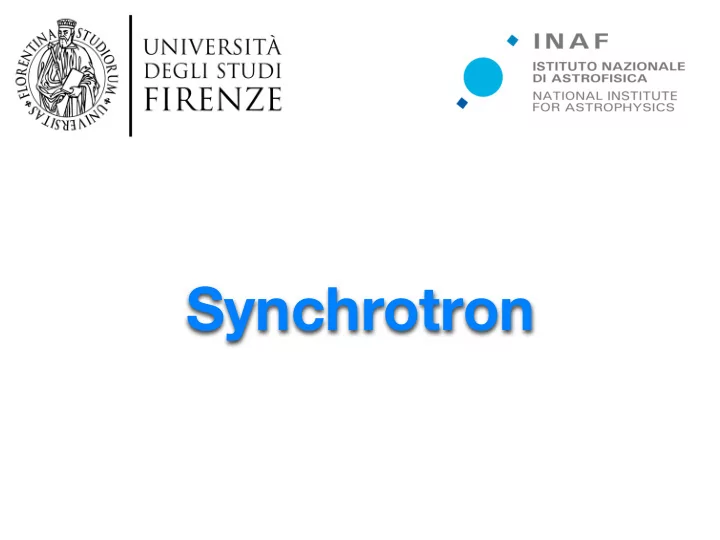

Synchrotron
Single particle spectrum Ghisellini Fig. 4.4 Top panel : The function F( ν / ν c ) describing the synchrotron spectrum emitted by the single electron. Bottom panel : F( ν / ν c ) is compared with some approximating formulae, as labeled. We have defined x ≡ ν / ν c A. Marconi Relativistic Astrophysics 2016/2017 2
From Cyclotron to Synchrotron Ghisellini Fig. 4.5 From cyclo to synchro: If the emitting particle has a very small velocity, the observer sees a sinusoidal (in time) electric field E(t) . Increasing the velocity the pattern becomes asymmetric, and the second harmonic appears. For 0 < β ≪ 1 the power in the second harmonic is a factor β 2 less than the power in the first. For relativistic particles, the pattern becomes strongly beamed, the emission is concentrated in the time � t A . As a consequence the Fourier transformation of E(t) must contain many harmonics, and the power is concentrated in the harmonics of frequen- cies ν ∼ 1 / � t A . Broadening of the harmonics due to several effects ensures that the spectrum in this case becomes continuous. Note that the fundamental harmonic becomes smaller increasing γ (since ν B ∝ 1 / γ )
Spectrum of a self-absorbed source Ghisellini Fig. 4.6 The synchrotron spectrum from a partially self-absorbed source. Observations of the self-absorbed part could determine B . Observations of the thin part can then determine K and the electron slope p A. Marconi Relativistic Astrophysics 2016/2017 4
The Radio emission of the Milky Way Map of Milky Way in the visible A. Marconi Relativistic Astrophysics 2016/2017 5
The Radio emission of the Milky Way Map of Milky Way in the radio at 408 MHz A. Marconi Relativistic Astrophysics 2016/2017 6
The Crab Nebula Fig. 5.10 Images of the Crab nebula at different wavelengths. Left upper : radio image from the NRAO; right upper : infrared image at 2 µ from 2MASS; left lower : optical image from VLT/ESO; right lower : high-resolution X-ray image from Chandra A. Marconi Relativistic Astrophysics 2016/2017 7
The Crab Nebula Sync. Inverse Di ff used Compton Star Light Sync. Dust A. Marconi Relativistic Astrophysics 2016/2017 8
Active Galactic Nuclei (AGN) galaxy: stars only → Introduzione all’Astrofisica A. Marconi Relativistic Astrophysics 2016/2017 9
The AGN Unified Model
Active Galactic Nuclei (AGN) A. Marconi Relativistic Astrophysics 2016/2017 11
Radio Galaxies Jet asymmetry = relativistic beaming A. Marconi Relativistic Astrophysics 2016/2017 12
3C 273 Photon energy 1 m eV 1 meV 1 eV 1 keV 1 MeV 1 GeV 10 3 a Accretion disk 1 Flux density F ν [JY] 10 –3 Hot dust X ray corona 10 –6 10 –9 Synchrotron 10 –12 10 –9 b ν F ν [erg/cm 2 /s] 10 –10 10 –11 10 –12 10 –13 10 9 10 12 10 15 10 18 10 21 10 24 Frequency [Hz]
M87
M87
Cygnus A Courvoisier 5.0 GHz 5 4 3 Cygnus A Radio Lobes 2 1 Log S ν (Jy) 0 Central Source − 1 170 kpc − 2 − 3 − 4 L − 5 − 6 0 1 2 3 4 5 6 7 8 9 10 11 12 13 Log n (MHz) Fig. 20.12 Radio to optical spectrum of Cygnus A (Hobbs et al. 1978, Fig. 1 p. L79, reproduced by permission of the AAS). The radio lobe spectrum shows a turnover near 20 MHz, then follows a power law with index − 0.8 up to 1 GHz and − 1.2 up to 100 GHz. The radio data of the central source are consistent with a rising spectrum (index 1/3), although a flat spectrum is not excluded
Cygnus A Radio - Synchrotron X Rays - Bremsstrahlung
Recommend
More recommend